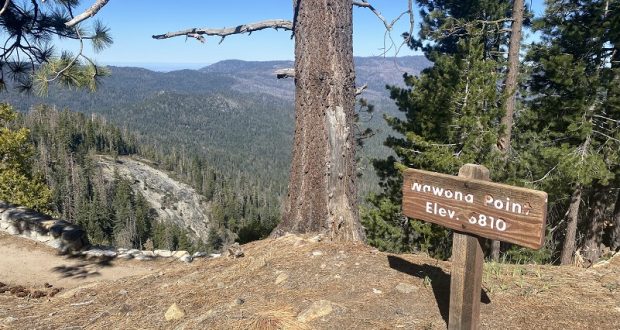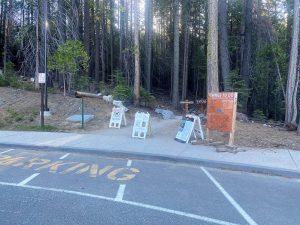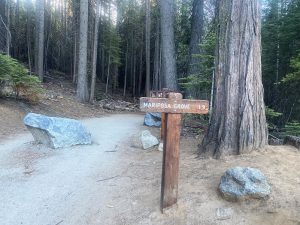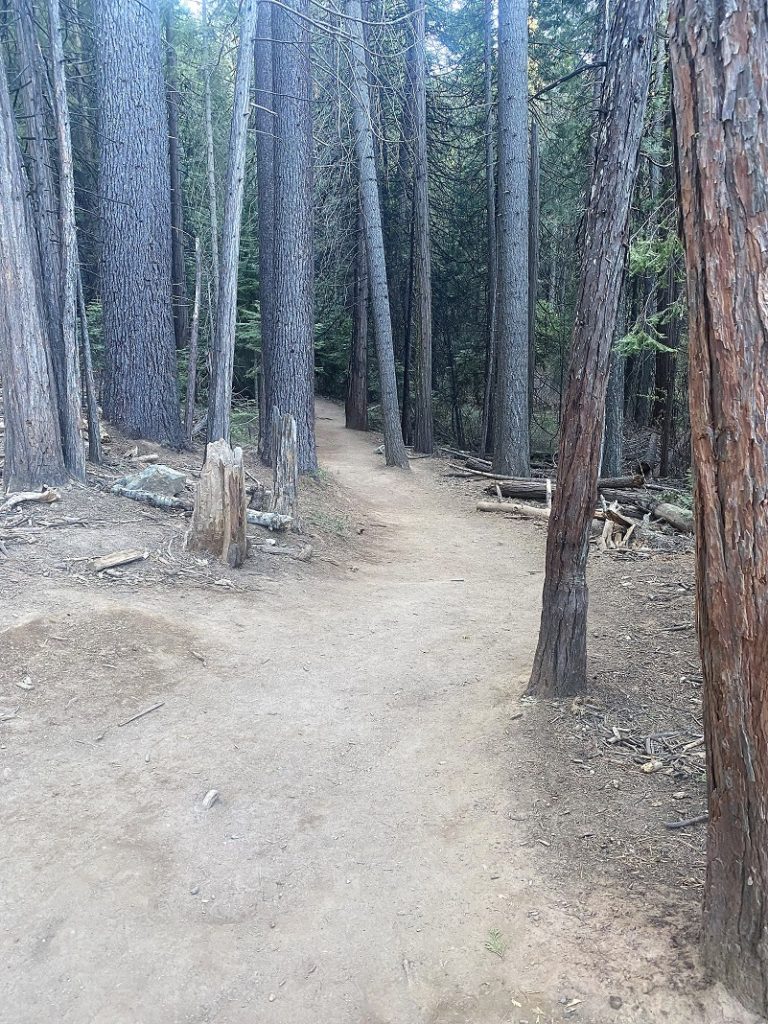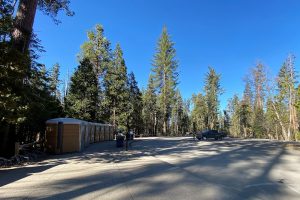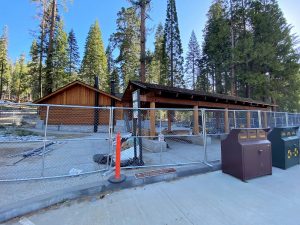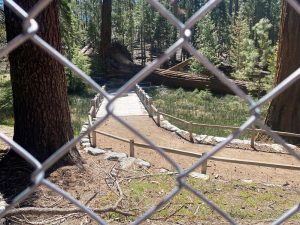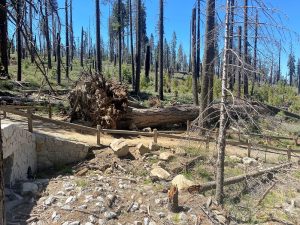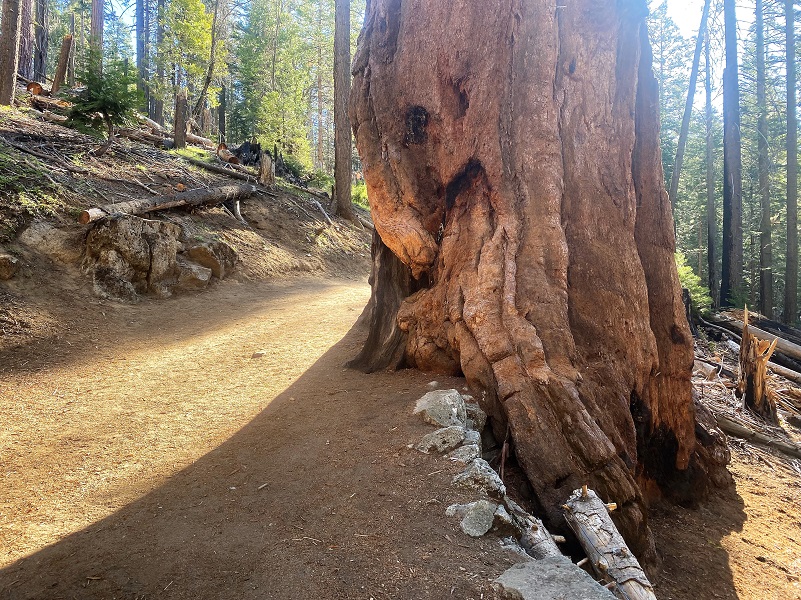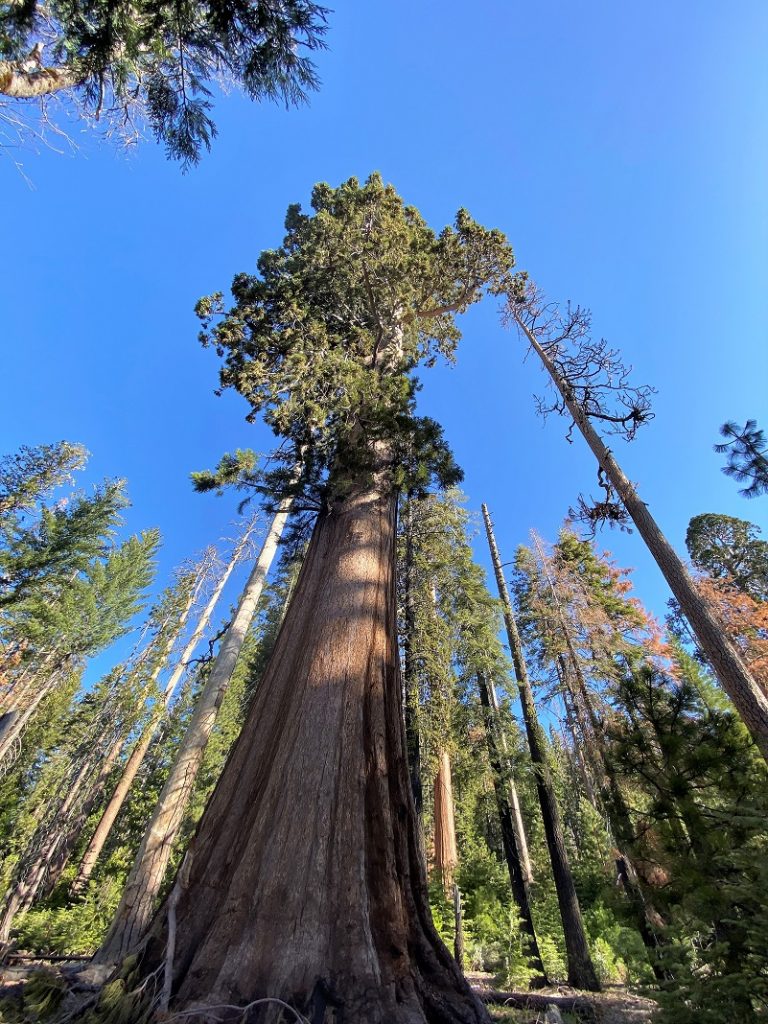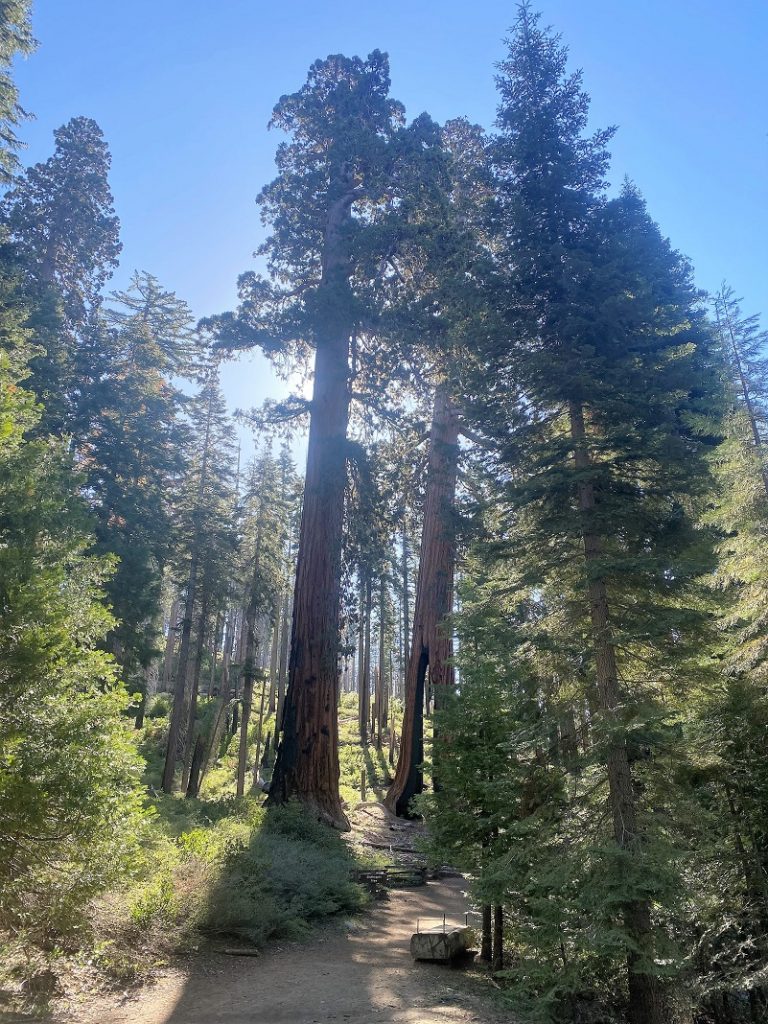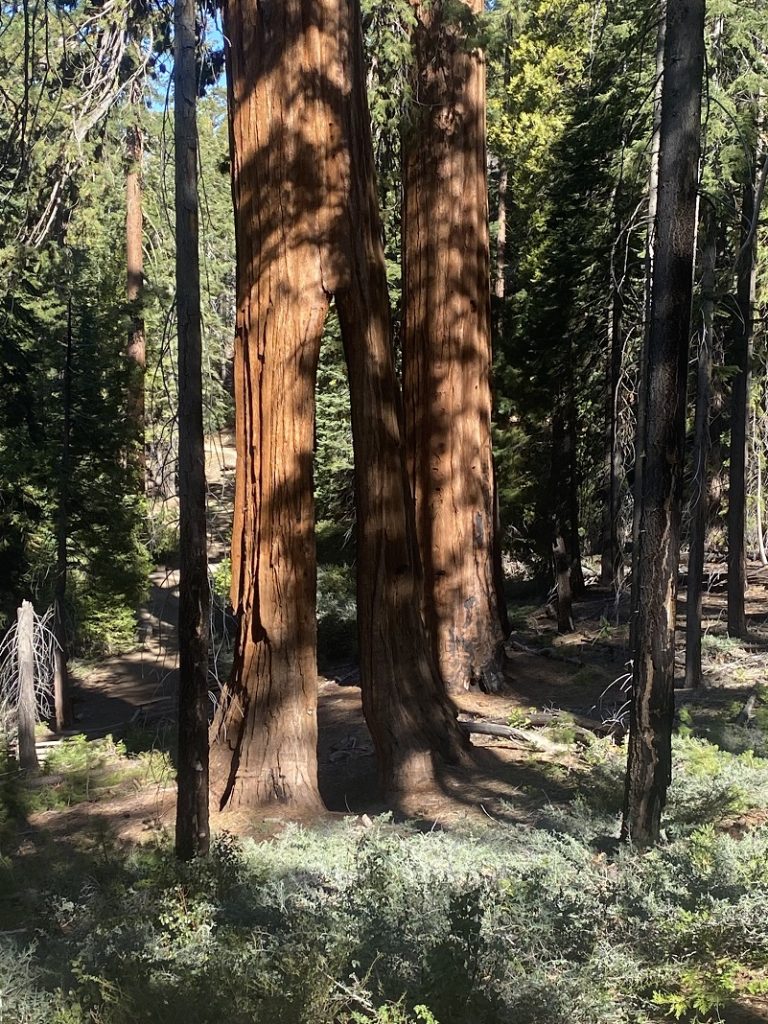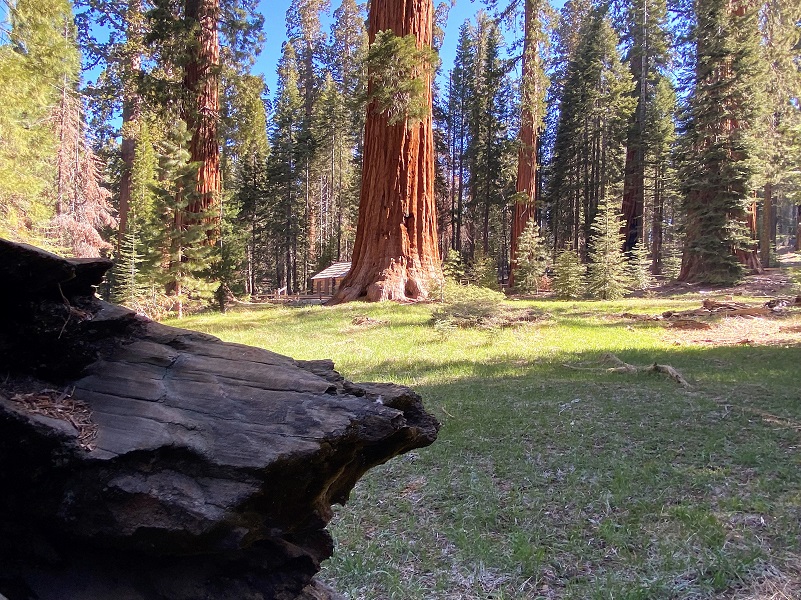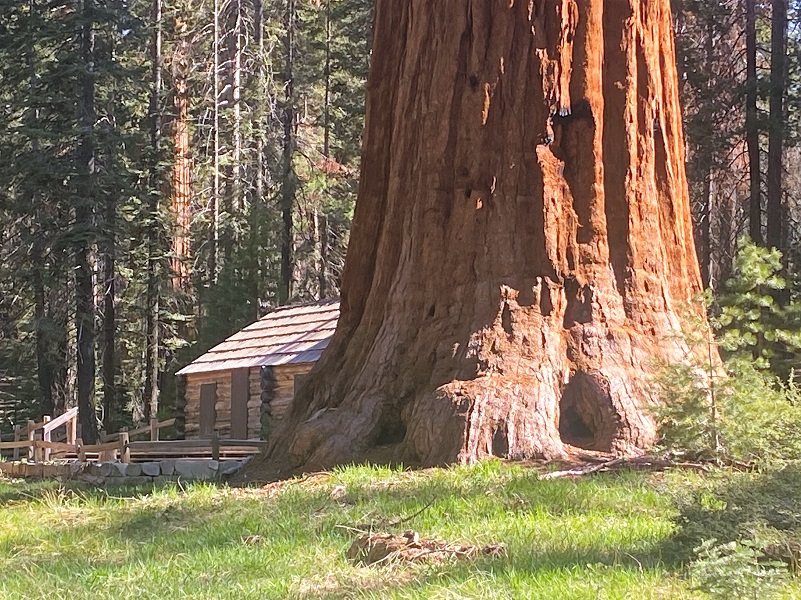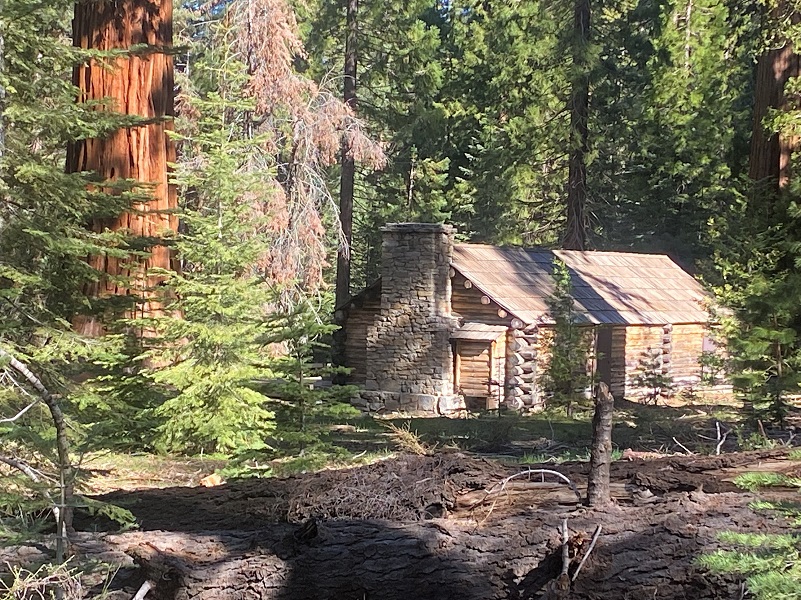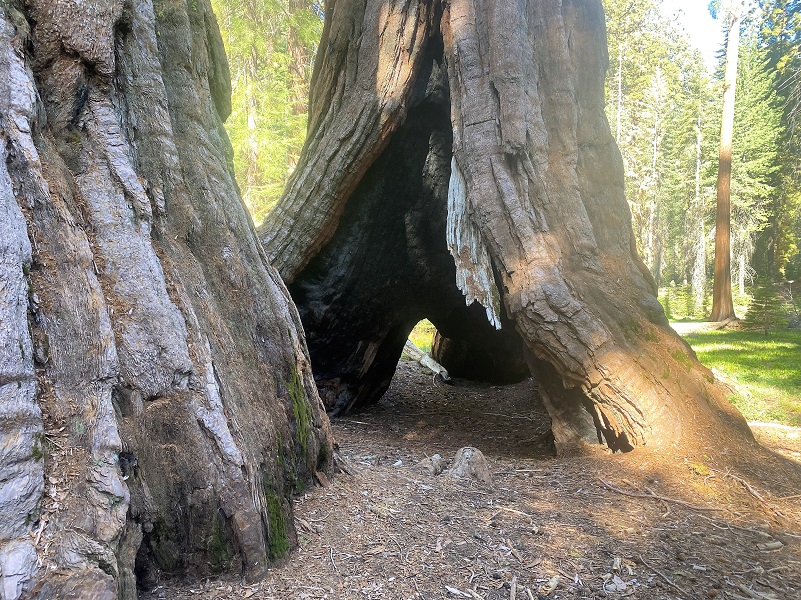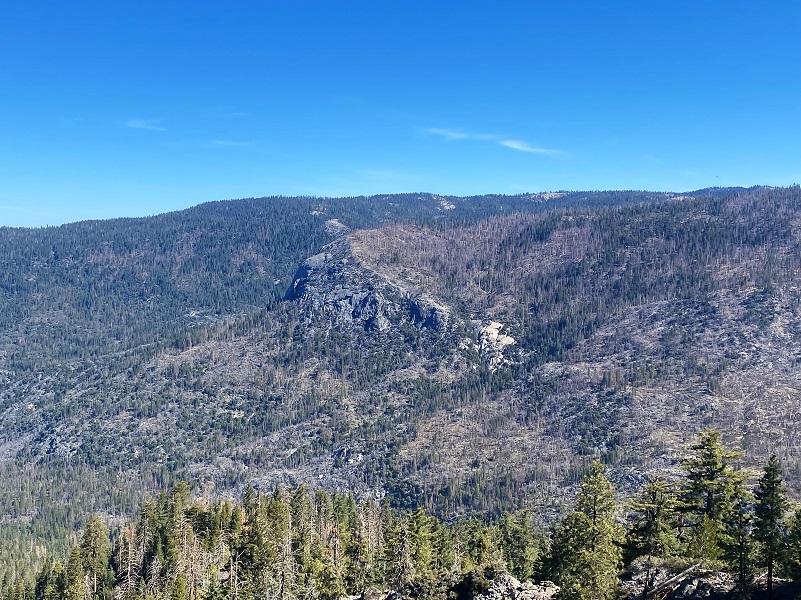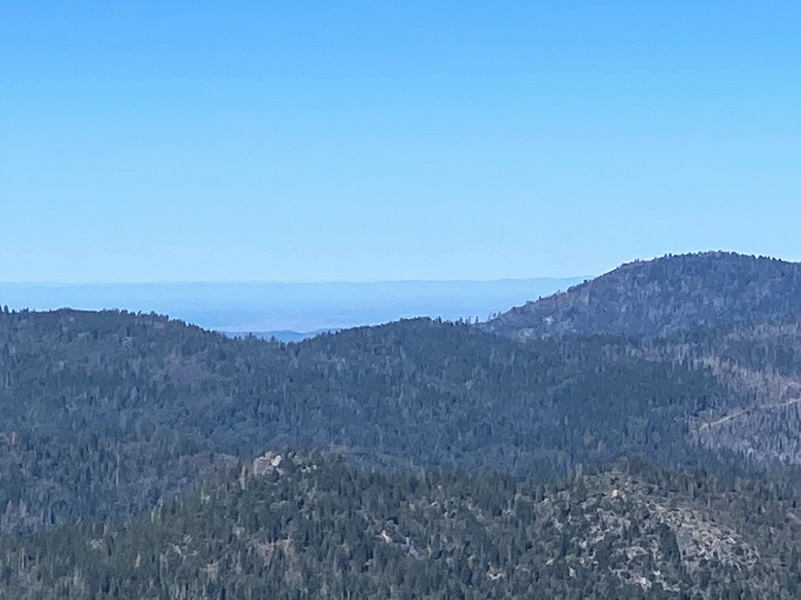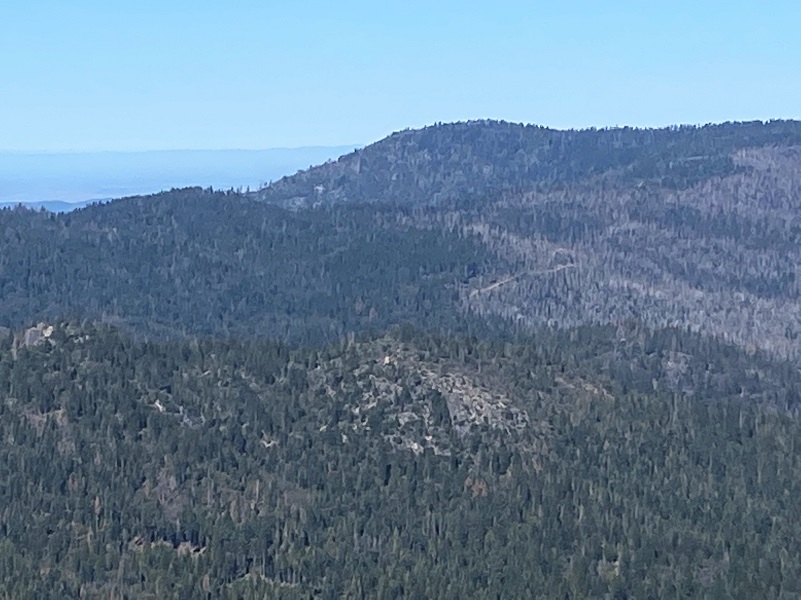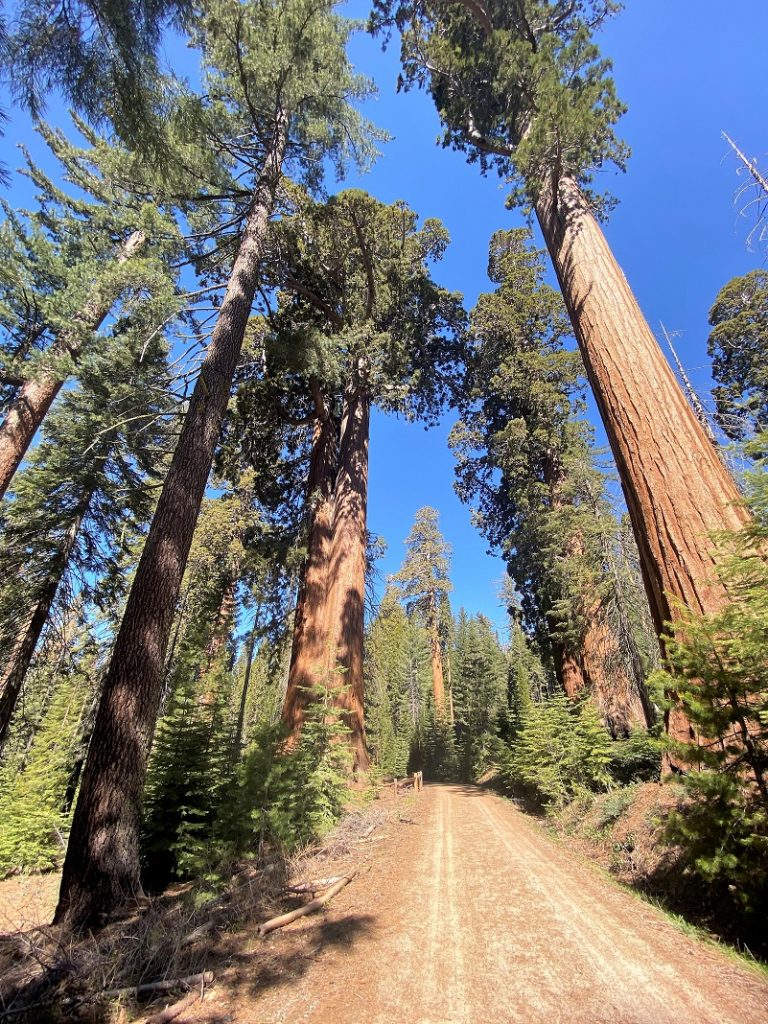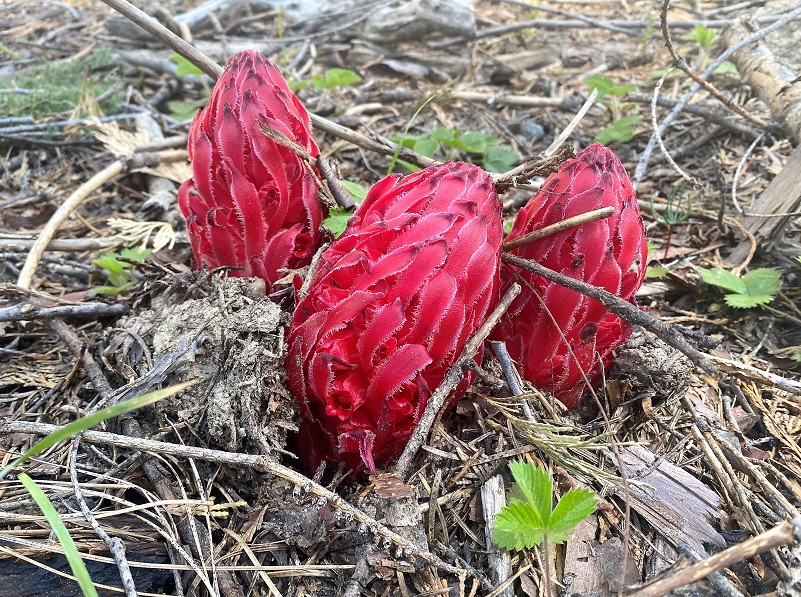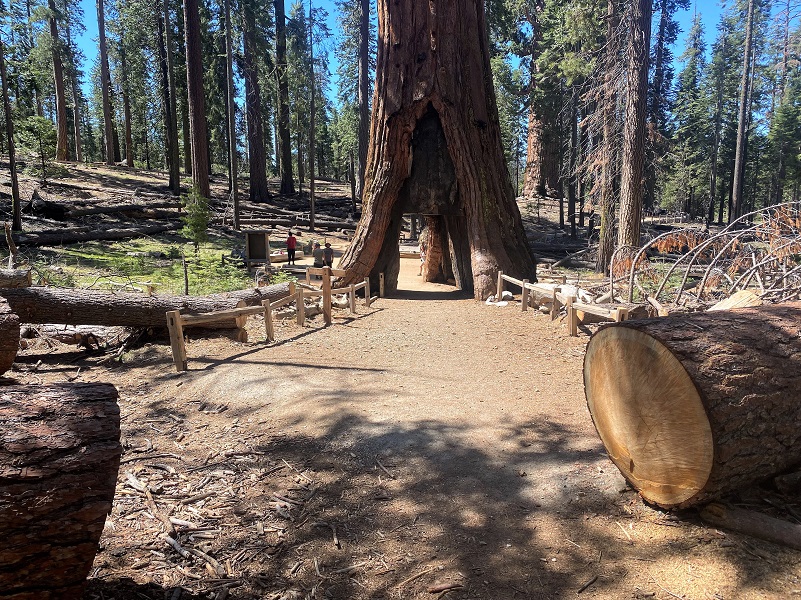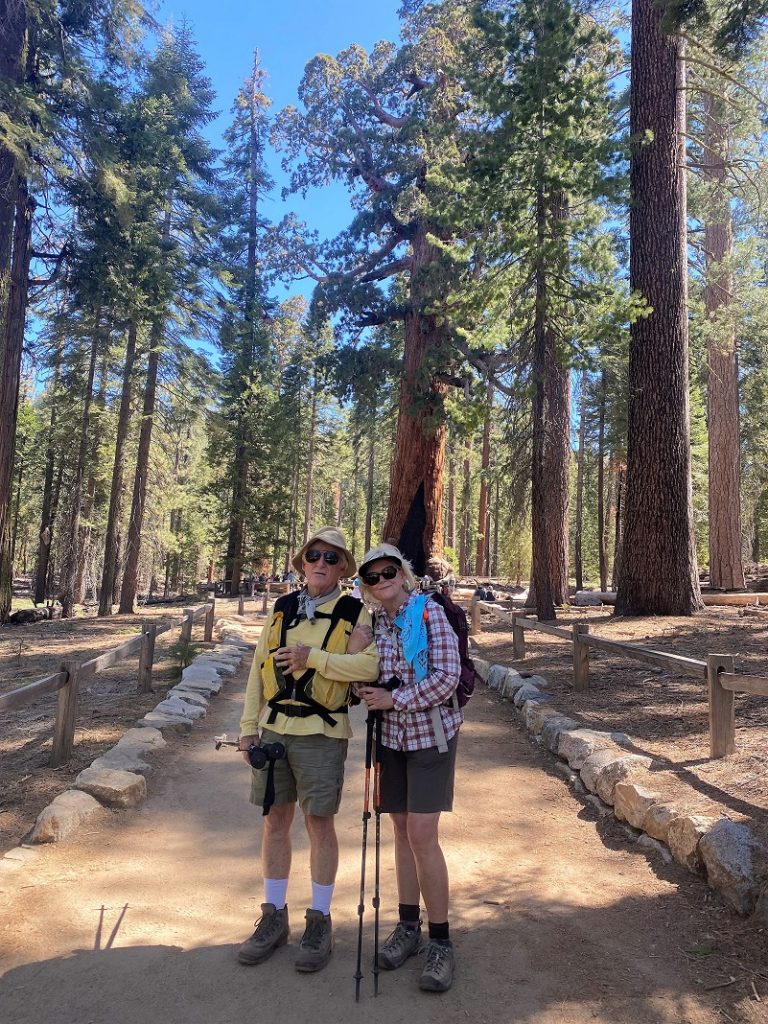Hiking beside really old, tall trees that have tiny cones is always special and a bit of Galen Clark’s cabin history along the way made it even better. It had been a while since I had hiked in Mariposa Grove and I got an early start to beat the crowd. And you probably should be careful when you tell me where you plan on hiking because I just may steal your idea and post your picture in the blog.
Where: Yosemite National Park, Mariposa Grove of Giant Sequoias
Distance: 10.89 Miles (but you can go shorter or farther)
Difficulty: Moderate
Elevation Range: 5,093′ – 6,805′
Elevation Gain: 1,926′
Date: May 16, 2022
CALTOPO: Mariposa Grove and Wawona Point Hike
Dog Hike? No, Pets are not allowed on any trails in the Mariposa Grove. Pets are allowed in the parking areas on leash only. Pets are not allowed on shuttles.
I headed up Hwy 41, through Yosemite’s South Entrance Gate around 7 am and it was staffed. I chatted with the person at the gate and she wanted to make sure I (and I am sure everyone coming through) was aware that starting May 20, Peak Hour Reservation Passes are required from 6 am until 4 pm May 20 through September 30 this year. This is in addition to Entrance Fees and Passes. In case you weren’t aware of this, you can find additional information here and I have included additional information from their website at the bottom of this blog. Just fyi, I checked and there are available dates where passes are available but suggest you book them sooner than later.
Proceeding through the Entrance Gate, I turned right and parked in the Welcome Plaza Parking Lot. The Shuttles were not running so you can walk up the road or use the Trailhead at the east end of the parking lot. Vehicles displaying a disability placard can either drive to the Mariposa Grove Welcome Plaza, park in a designated space, then ride the shuttle when it gets up and running, or they can drive up the Mariposa Grove Road and park at the Mariposa Grove Arrival Area or at the Grizzly Giant accessible parking area. Parking is limited, especially at the Mariposa Grove Arrival Plaza due to construction.
I walked over to the Trailhead. I hadn’t been on this newer trail and was looking forward to checking it out.
I headed up the trail and it was a nice, easy trail with a little bit of a rolling grade. It went through different type of vegetation, some very shady and other stretches more open and in the sun. The two bridges it crossed over were very pretty.
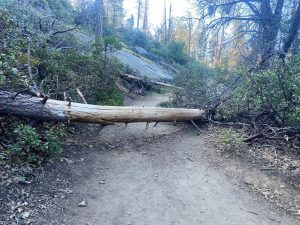 There were a few down trees but nothing that couldn’t be stepped over.
There were a few down trees but nothing that couldn’t be stepped over.
When I reached the Mariposa Grove Arrival Area, I was greeted by a few porta-potties. The restrooms were under construction and closed when I visited and construction was also taking place on the beautiful boardwalk that was destroyed in areas where huge trees came down in the winds.
There are several ways to hike this area, but please keep in mind that with the down trees across some of these trails, they may not be accessible at the time of writing this blog, but they will be! From Yosemite National Park:
Big Trees Loop Trail (easy)
-
- 0.3 mile (0.5 km) loop from trailhead, 30 to 45 minutes (wheelchair accessible)
- Begin at Mariposa Grove Arrival Area. Winding through a forest with many giant sequoias, this trail features the Fallen Monarch and interpretive panels on the life and ecology of giant sequoias. This loop is relatively flat and is wheelchair accessible.
Grizzly Giant Loop Trail (moderate)
-
- 2 miles (3.2 km) loop from trailhead, 1.5 to 2 hours
- Begin at Mariposa Grove Arrival Area. Start along the Mariposa Grove Trail at the Big Trees Loop and hike past notable trees such as the Bachelor and Three Graces, the 3,000-year-old Grizzly Giant, and California Tunnel Tree. Allow two hours to enjoy the full loop that winds along the edge of the grove and includes 300 feet (91 m) of elevation gain. Visitors with a valid disabled placard can drive as far as the Grizzly Giant parking area and enjoy this area of the grove via a section of trail that is wheelchair accessible.
Guardians Loop Trail (strenuous)
-
- 6.5 miles (10.5 km) round trip from trailhead, 4 to 6 hours
- Begin at Mariposa Grove Arrival Area. After hiking to the tranquil upper portion of the grove, a 1.5-mile (2.4 km) loop takes hikers past many famous features including the fallen Wawona Tunnel Tree, the Telescope Tree, and the Mariposa Grove Cabin.
Mariposa Grove Trail (strenuous)
-
- 7 miles (11.3 km) round trip from trailhead to Wawona Point, 4 to 6 hours
- Begin at Mariposa Grove Arrival Area. This wide and relatively smooth trail follows a route that people have used to access the grove for generations. See famous sequoias such as the Bachelor and Three Graces, the Faithful Couple, and the Clothespin Tree along this somewhat strenuous route to the upper reaches of the grove. Continue to historic Wawona Point, an overlook with panoramic views. Total elevation gain is 1,200 feet (366 m). A number of alternative trails may be used to access the upper portion of the grove. These trails are generally steeper and more primitive than the Mariposa Grove Trail.
I followed the signs, headed up the road/trail and caught a few glimpses of some of the down trees along the boardwalk from the trail. When the boardwalk reopens, it will be interesting to get a closer look at the damage and repairs.
I continued toward the Grizzly Giant and I won’t go on with trail descriptions because I think it will be too confusing. I headed toward whatever tree caught my interest, heading uphill toward Wawona Point.
They say that there are over 500 mature Giant Sequoias in this grove and the oldest may be older than 3,000 years. From Wikipedia, some of the trees found in the grove that are worthy of special note are:
-
- The Fallen Monarch: A giant sequoia that fell more than three hundred years ago. Giant sequoias are resistant to decay, so their remains can linger for a long period of time if undisturbed.
- The Bachelor and Three Graces: A group of four giant sequoias, three of them growing very close together, with a fourth a little more distant. Their roots are so intertwined that if one of them were to fall, it would likely bring the others along with it.
- The Grizzly Giant: The oldest tree and second largest tree in the grove, with a volume of 34,010 cubic feet.
- The Washington tree: The largest tree in the grove, with a volume of 35,950 cubic feet.
- The General Sheridan tree: A large, 286 feet tall giant sequoia located south of the Mariposa Grove Cabin.
- The General Grant tree: A large giant sequoia located west of the Mariposa Grove Cabin. Not to be confused with the General Grant Tree of Sequoia National Park.
- The Columbia tree: The tallest tree in the grove and in Yosemite National Park at 286 feet.
- The California Tunnel Tree: Cut in 1895 to allow coaches to pass through it (and as a marketing scheme to attract visitors to the grove), this is the only living giant sequoia tree with a tunnel in it since the fall of the Wawona Tunnel Tree in 1969 and the fall of the Pioneer Cabin Tree in 2017.
- The Faithful Couple: A rare case in which two trees grew so close together that their trunks have fused together at the base.
- The Clothespin tree: Countless fires throughout the decades nearly severed this tree’s trunk, creating a space in it large enough for a pick-up truck to drive through.
- The Telescope tree: A giant sequoia tree that has become completely hollow from repeated fires through the decades. Despite that, the tree is still living, as giant sequoias do not require a whole trunk to survive. It is possible to walk inside the tree and, from there, see the sky. This condition leaves the tree weakened and makes it more difficult for it to withstand strong winds. This tree (and the Clothespin Tree) could topple at any time.
- The Galen Clark tree: Of historical importance, as it is said to be the first tree seen by Galen Clark when he entered the grove, and inspired his love for the giant sequoias and struggle for setting aside the land for preservation, a new concept in the mid-19th century.
- The Wawona Tunnel Tree: Renamed the “Fallen Tunnel Tree” after it toppled over during a snow storm in 1969. In 1881, this was the first tree to have a tunnel carved through its trunk. Its collapse is seen as a turning point in the preservation program in national parks in the United States. So grave was the shock of the tree’s collapse that the result was a greater awareness of the sensitivity of ecosystems, even for a living thing as massive as the giant sequoias.
- The Fallen Giant: It was one of the largest trees in the grove, until it fell in 1873.
- The Massachusetts tree: It was one of the most famous trees in the grove. It fell in 1927.
Pictures do not begin to do justice to these huge trees.
I wandered through the Upper Mariposa Grove, in awe of the size and age of these Giant Sequoias. I am always blown away when I get my first look at the Mariposa Grove Cabin. It sits in such an beautiful spot.
The original cabin was built by Galen Clark.
From Yosemite’s Pioneer Cabins By ROBERT F. UHTE:
At the Mariposa Grove, Clark built a cabin about approximately 1.5 miles from the densest collection of trees, including the famed Grizzly Giant with its 92-foot base circumference. The tiny cabin used to serve as the Mariposa Grove Museum. Since the grove underwent restoration improvements in 2015, the cabin was boarded up, and some contents were moved to the exhibits at the bus stop near the parking area by the South Park entrance. It’s also known as the Mariposa Grove Cabin.
Mariposa Grove.—Galen Clark built his first log hut in the Mariposa Grove in 1858, a year after his discovery of the grove. Two photos taken about this time purport to be of the original cabin, but the differences in the photographed structures indicate that there were two different cabins on the same site. The two cabins are of the same size and in the same place, but the earlier one had shake chinking and an uncovered triangular stockade at one end, which possibly was used as a kitchen. There was no covering over the triangular area so a chimney was unnecessary.
According to the Yosemite Valley Commissioners’ Biennial Report, 1885-1886, still another one-room log cabin was constructed in the grove, “for the shelter and convenience of visitors.” Several years later, it was lengthened by the addition of another room. This structure, generally known as the “Galen Clark Cabin,” stood for the next forty-five years, and its fame spread throughout the world, largely through the agency of photographs depicting it and its astonishing setting. In 1930 the Park Service replaced it, for owing to decay its collapse seemed imminent.
The new cabin stands on the original site, and while not an exact duplication of its predecessor, resembles it enough to carry on the tradition. We can fancy it is just the sort of log cabin Galen Clark would have built had building conditions been as favorable in his day. It differs structurally from the cabin it replaced, but not in general design. Every measure has been taken to insure it long life. It has a rubble masonry foundation and a reinforced chimney. It is constructed of carefully fitted sugar-pine logs tied with steel dowel-pins and chinked with split-log strips over oakum packing. The shake roof is laid on roofing paper and solid sheathing. It has doweled, random-width oak flooring. The cabin now houses a small museum exhibit devoted to the sequoias.
I continued wandering up the road/trail. Fire scars were evident on the larger trees, helping to show how fire has burned through the grove over the decades. The Giant Sequoias are considered to be adaptive to fire. Their bark is very thick, up to 18 inches thick and can protect them if the fire isn’t too intense. Studying Giant Sequoia tree rings show us that frequent surface fire commonly occurred over the past 2,000 years but this pattern changed around 1860 and the frequency of fires decreased significantly. When frequent fires run through the area and clear out the undergrowth, it can result in fires that are not as destructive to them. When fire is excluded from these groves, the fuels build up to dangerous levels and the fire that does eventually come through can kill the trees. Prescribed fires are being used to try and help keep these groves healthier.
Today, there are only about 75 groves of Giant Sequoia and they are all located in Central California along the west slope of the Sierra Nevada from Tulare County up to Placer County. The giant sequoia is listed as an endangered species by the International Union for Conservation of Nature. Since its last assessment as an endangered species in 2011, it was estimated that another 13–19% of the population (or 9,761–13,637 mature trees) was destroyed during the Castle Fire of 2020 and the KNP Complex & Windy Fire in 2021. The 2017 Railroad Fire burned into our own local Nelder Grove, killing many sequoia. I have not seen a count but the loss is huge. Sources say that fewer than 80,000 Giant Sequoia trees remain. But there are other issues negatively impacting the Giant Sequoia. Prolonged drought is stressing these trees. When I was a Forestry Major at Humboldt State University, we were told that Giant Sequoias did not get attacked by bark beetles but we have now learned that is not true. Our changing climate is a big threat to these trees and when a tree is stressed, it can become susceptible to things it may not be when it is healthy.
As huge as these trees are, they have a pretty small cone, about 2-3 inches long. The cone can retain its seeds for 20 years or so and when a fire moves through the grove, clearing out lower vegetation and preparing a seedbed, the dry air and heat help open up the older cones to distribute their seeds. These seeds need fire to prepare that seedbed or they will not germinate.
It wasn’t long before I reached Wawona Point. I couldn’t believe that I hadn’t seen a single person on my way up and had the Point to myself.
There are two areas with different views and I checked them both out. As expected, the views were very nice. I could look down into Wawona Meadow.
And just over that big chunk of rock is Chilnualna Falls.
It wasn’t a super clear day but it was clear enough to see the the Coast Range.
But I could also see the the old wagon road that led to Wawona that we call the Chowchilla Mountain Road today.
I continued down the road.
Right along the road, I spotted a small group of Snowplants, then I looked farther down the side of the road and saw many more. This was a pretty big group of about 25 or so, in mini groups of threes or so. Some were getting ready to finish their flowering and others were just getting going. They are a parasitic plant that obtains its sustenance and nutrients from mycorrhizal fungi that attach to roots of trees. They don’t have chlorophyll and unable to photosynthesize. Ectomycorrhizal (EM) symbioses involve a mutualism between a plant root and a fungus; the plant provides fixed carbon to the fungus and in return, the fungus provides mineral nutrients, water and protection from pathogens to the plant. The snow plant takes advantage of this mutualism by tapping into the network and stealing sugars from the photosynthetic partner by way of the fungus. This form of parasitism is known as mycoheterotrophy.
I had wandered down a slightly different way than I had come up and started meeting people around the California Tunnel Tree,
Then many more around the Grizzly Giant. Then I needed to fess up because I ran into members of the Sierra Hiking Seniors that were heading up to Wawona Point. I had to admit to them that I stole their idea for a hike but wanted to start earlier and that is what I did. They didn’t seem too upset about this idea as I offered to take a picture of two of them in front of the Grizzly Giant. It was a really good hike idea though, definitely worth stealing!
I have gone with the Sierra Hiking Seniors on a few hikes over the years and they are a fun group of hikers of all speeds. They hike on Monday and Friday, putting out a calendar and weekly emails on their hikes. If you are interested in joining them on a hike or receiving their emails with information on upcoming hikes, you can contact Fran Goss at sierrahikers@sti.net.
I started my hike early for a few reasons and the biggest was to avoid the crowds. This area is very popular and on weekends or during the day, it is quite crowded. It was also a bit of a warmer day and I got my uphill in in the cooler morning. If a breeze isn’t blowing, gnats can be an issue in the warmer weather. And in the winter, this is a fun one to snowshoe! Bring plenty of water with you and there are many spots where you can sit, have a snack or just gaze at the beauty in Mariposa Grove.
Peak Hour Reservation Pass Information
The Peak Hour Reservation Passes went on sale on May 23 and here is information from Yosemite National Park:
Seventy percent of reservations for all dates from May 20 through September 30, 2022, will be available on Recreation.gov on March 23. Thirty percent of reservations will be available seven days before the arrival date (e.g., make a reservation for an arrival date of September 30 on September 23).
Reservations are available each day at 8 am Pacific time. Reservations are taken almost immediately. Be sure to have a Recreation.gov account and be logged in and ready to get a reservation promptly at 8 am Pacific daylight time.
The non-refundable reservation fee is $2 (this does not include the $35-per-car park entrance fee).
Each user can make one reservation for each three-day period. For example, if a user makes a reservation for a Friday arrival (valid Friday through Sunday), the user won’t be able to make a second reservation for an arrival that Friday, Saturday, or Sunday. The reservation holder must be in the arriving vehicle and show photo ID at the entrance station.
Peak-hours reservations are valid for three consecutive days (including arrival date).
If you don’t have computer access, you can call 877/444-6777 to make a reservation.
In-Park Camping, Lodging, or Vacation Rentals
If you have a reservation for one of the following, you do not need an additional reservation. You still pay the $35-per-car entrance fee upon arrival (credit card only) unless you have an annual or lifetime pass. Your reservation for in-park lodging or camping, a Half Dome permit, or a wilderness permit allows you to enter the park 24 hours per day for the duration of your reservation or for three days (whichever is longer).
-
-
-
Curry Village, Housekeeping Camp, Yosemite Valley Lodge, The Ahwahnee, White Wolf Lodge, Tuolumne Meadows Lodge, or Wawona Hotel
-
Private lodging or vacation rental in Wawona, Yosemite West, or Foresta
-
Yosemite wilderness permit
-
Reservations for lodging or vacation rentals outside the park and in communities other than these three do not provide access to Yosemite.
Wilderness or Half Dome Permits
If you have a wilderness permit reservation (for backpacking) or Half Dome permit, you do not need an additional reservation. You still pay the $35/car entrance fee upon arrival (credit card only) unless you have an annual or lifetime pass. Your reservation allows you to enter the park 24 hours per day for the duration of your reservation or for three days (whichever is longer).
If you have a wilderness permit, you may enter the park a day before the date on your wilderness permit to stay at a backpackers campground.
A Half Dome permit does not allow you to camp in Yosemite.
Regional Transit or Tour Groups
If you enter the park on a Yosemite Area Regional Transportation System (YARTS) bus or with an authorized tour group, you do not need an additional reservation or permit.
Dog Hike? No
Dogs are not allowed on any of the Mariposa Grove Trails. Pets are allowed in the parking areas on leash only. Pets are not allowed on shuttles.
Where Pets Are Not Allowed
- On trails, including the trail to Vernal Fall (however, pets are allowed on the Wawona Meadow Loop)
- On unplowed roads covered in snow
- In undeveloped and wilderness areas
- In public buildings
- On shuttle buses
- In lodging areas
- In all walk-in and group campgrounds/campsites, including Camp 4
- In any other areas, as signed
These regulations protect both pets and wildlife from disease and each other. The National Park Service has prohibited pets on trails for many years. In particular, some pets chase wildlife, pollute water sources, and can become defensive and dangerous in unfamiliar surroundings. Pet owners have the burden to assure their pet does not damage the park values for others in those areas where pets are allowed.
Doarama:
What is a Doarama? It is a video playback of the GPS track overlaid on a 3 dimensional interactive map. If you “grab” the map, you can tilt it or spin it and look at it from different viewing angles. With the rabbit and turtle buttons, you can also speed it up, slow it down or pause it.
Mariposa Grove to Wawona Point Doarama
Map and Profile:
CALTOPO has some free options for mapping and here is a link to my hike this week: CALTOPO: Mariposa Grove and Wawona Point Hike
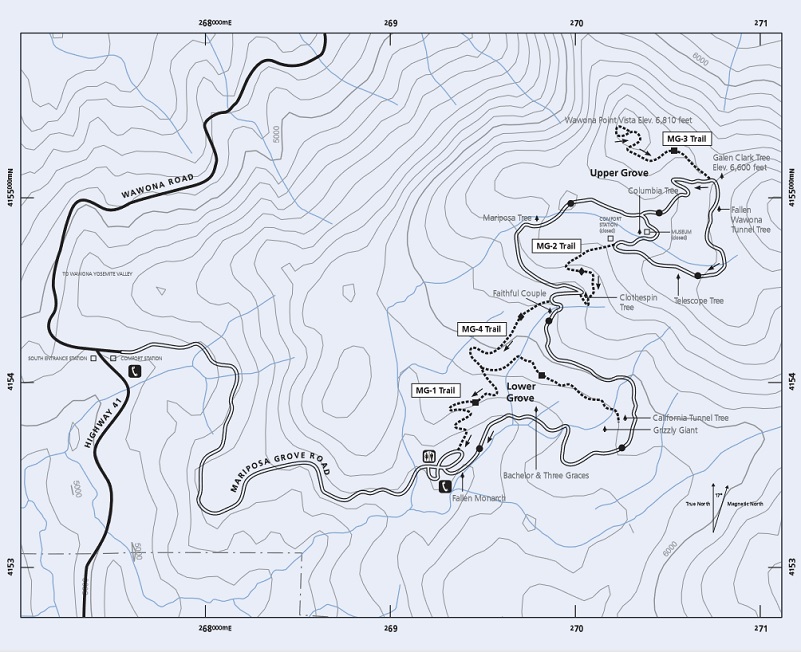
Mariposa Grove Winter Trails (Courtesy National Park Service, Yosemite Association and The Yosemite Fund)
Sources:
Mariposa Grove of Giant Sequoias
Yosemite National Park Entrance Reservation Information
Preliminary Estimates of Sequoia Mortality in the 2020 Castle Fire
Mariposa Grove Galen Clark Cabin
Yosemite’s Pioneer Cabins By ROBERT F. UHTE [Sierra Club Bulletin 36(5) (May 1951)]
Prior Blogs in the Area:
Snowshoeing to Upper Mariposa Grove March 11, 2019
Mariposa Grove Reopens June 15 and I Have Hiked it! June 13, 2018

